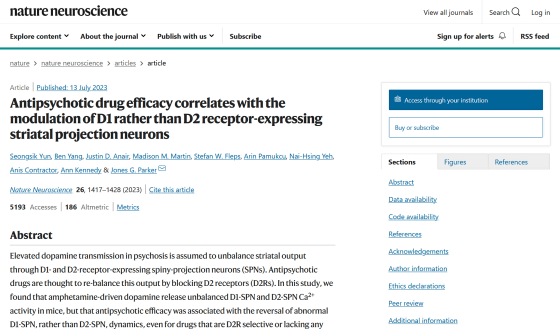Research results that neurons targeted by antipsychotic drugs may have been misunderstood for decades

Antipsychotic drug efficacy correlates with the modulation of D1 rather than D2 receptor-expressing striatal projection neurons | Nature Neuroscience
https://doi.org/10.1038/s41593-023-01390-9

Everyone Was Wrong About Antipsychotics | WIRED
https://www.wired.com/story/everyone-was-wrong-about-antipsychotics/
Schizophrenia Drugs May Have Been Off Target For Decades, Study Finds : ScienceAlert
https://www.sciencealert.com/schizophrenia-drugs-may-have-been-off-target-for-decades-study-finds
Many historically important drugs were discovered by sheer chance, and the antipsychotic drug chlorpromazine , which was approved in 1954, was originally developed as a sedative, but it happened to be a psychiatric drug. There is a history of confirming its effectiveness. ``These drugs were discovered by accident, so we don't really know what they're doing in the brain,'' says Jones Parker, a neuroscientist at Northwestern University.
Neuroscientists have long believed that antipsychotics bind to dopamine receptors on spiny projection neurons (SPNs), which make up 95% of the brain's striatum , and inhibit extreme dopamine transmission. . There are two types of dopamine receptors, the D1 and D2 receptors . Experiments in the 1970s based on calf brain extracts showed that potent antipsychotic drugs strongly bind to the D2 receptor. , the development of new antipsychotics has been designed and improved with the D2 receptor in mind for decades.
However, the development of new antipsychotic drugs is a difficult road despite huge investments by pharmaceutical companies, and there is also the problem that about 30% of patients are not getting the effect of antipsychotic drugs. Parker et al.'s research team conducted experiments using mice to investigate how various antipsychotic drugs actually function in the brain.

The research team first administered
Next, haloperidol , olanzapine , clozapine , which have been confirmed to be effective as antipsychotics, and MP-10, which was developed by Pfizer but was not approved because it was confirmed in clinical trials to exacerbate psychotic symptoms. He said that he administered the drug and investigated how it works in the brain of the mouse.
As expected, haloperidol and olanzapine moderated the effects of amphetamine at D2 receptors, but clozapine had no significant effect at D2 receptors. Furthermore, all three drugs that are effective as antipsychotics have been confirmed to normalize the activity of the D1 receptor, suggesting that the action on the D1 receptor rather than the D2 receptor is responsible for the drug's effect. was suggested. On the other hand, MP-10, which had no effect as an antipsychotic, normalized the activity of D2 receptors, but it was also confirmed that it exacerbated the abnormal activity of D1 receptors.
In addition, when Parker et al. investigated promising new drugs that had advanced to the final clinical trial required for approval by the US Food and Drug Administration (FDA), it was found that all antipsychotic drugs also normalize D1 receptors. Ta. Behavioral observations in mice also showed that all antipsychotics, except MP-10, which was known to be ineffective, helped suppress amphetamine-induced aberrant movements.

The research team said, 'These findings provide a new explanation for the efficacy of antipsychotics,' and the possibility that D1 receptors, not D2 receptors, are the main driving force for antipsychotics. pointed out that there is The results of this research may lead to the development of new antipsychotic drug approaches that are different from the past, and lead to the development of new drugs that are superior in terms of efficacy and side effects.
Related Posts:
in Science, Posted by log1h_ik







